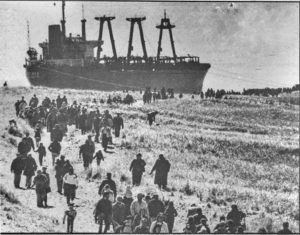
A photo of Great Point Lighthouse after being toppled in the storm. Courtesy of the Nantucket Historical Association.
When one thinks of legendary storms that have struck Cape Cod a few come to mind. The Blizzard of ‘78, Hurricane Bob, the Great New England Hurricane of 1938, and the No Name (Perfect) Storm of 1991 conjure up memories of high winds, snow/rain, and swaths of damage left behind. However there is another storm that though it may not be as remembered as those previously mentioned it did manage to leave its mark on history with two mammoth events. This storm occurred on Thursday March 29, 1984.
The early spring storm began racing eastward a few days earlier blistering Utah, Colorado, and New Mexico with winds of over 60 mph and threatening those locations with snow as well. The storm gained size and strength as it approached the east coast. On March 28th the storm unleashed numerous tornadoes in the Carolinas killing at least 59 people. At its peak the storm covered the United States from Georgia north to New England and from Tennessee east to 1,000 miles off of the east coast.
In the end some spots in the Northeast were blanketed under two feet of snow. The Atlantic City Boardwalk was washed away and more than a million people lost power. Cape Cod was not spared the wrath of the storm by any means. The island of Nantucket also received a lashing from the early spring blizzard.
The northeast corner of Nantucket is home to the 1,117-acre Coskata-Coatue Wildlife Refuge. Part of this conservation area is the sandy spit stretching north known as Great Point. It is a haven for fishing, ORV traveling, seal and snowy owl watching, or simply enjoying the incredible solitude. The centerpiece of Great Point is the eponymous lighthouse. The original wooden structure at what was then known as Sandy Point was completed in 1785. This was suspiciously destroyed by fire in 1816. A new 60-foot-tall stone tower was erected in 1818; this one would stand the test of time.
On March 29, 1984 the early spring blizzard roared across Great Point with winds at times touching hurricane-force (over 74 mph). At the time of high tide, with winds steady between 35-65 mph Great Point Lighthouse came crashing down, leaving a large pile of stone rubble on the beach. In the time leading up to, and just after, the lighthouse’s destruction there had been outcry from locals about the need to replenish the beach surrounding the lighthouse for fear of erosion claiming the beacon. Sadly nothing had been done and the 166-year-old structure was destroyed. Although the Coast Guard had said in the previous few years that if Great Point Light was ever to come down that a replacement might not be necessary officials changed their minds after the blizzard toppled the light.
In October 1984 $2 million ($4.9 million in 2019) was appropriated for the construction of a new Great Point Lighthouse. A temporary lighthouse beacon would be placed at Great Point while the construction of the new lighthouse began by the New Bedford-based Hydro-Dredge Corporation. On Saturday September 6, 1986, just over two years after its destruction during the storm, a replica of Great Point Lighthouse was dedicated by Senator Edward Kennedy. Fireworks had been planned but had to be postponed until three weeks later due to dense fog. To this day the new Great Point Lighthouse is still standing stoically and shining its beacon to guide passing vessels.

A photo of people crossing the Nauset dunes to see the Eldia. Courtesy of the Orleans Historical Society.
Nearly thirty miles north of Great Point Lighthouse a different sort of calamity took place during the early spring blizzard in March of 1984. Nauset Beach in Orleans has always seen some of the largest waves on Cape Cod making it a popular surfing site. On March 29, 1984 something a bit larger than a surfer rode the waves into shore. During the height of the storm a call came in to the Orleans Police Department about a boat in trouble just off shore of Nauset Beach. After having received numerous false alarm calls during the day the police were hesitant to investigate but decided to brave the storm. What they found was beyond what they had expected.
Floundering among the shoals was a 473-foot, 9,000-ton freighter named Eldia. Bound for Norfolk, Virginia the Maltese ship had dropped off its cargo of sugar in St. John, New Brunswick the previous day. Captain Ernesto Garces and his crew of twenty-two had hoped to avoid the brunt of the storm. However with no cargo inside the ship was too light and was forced into the shoals. The entire crew was recused by Coast Guard helicopter and within a week the Eldia had become embedded on the shore of Nauset Beach about a half-mile south of the main parking lot.
The ship’s grounding became a huge attraction with upwards of 30,000 people heading to Nauset Beach to view the vessel as it waited to be dislodged from the sand in the first week alone. Luckily very little of the 140,000 gallons of fuel had leaked out of Eldia before being drained by the Coast Guard and sent to New Bedford for storage. The task of removing the freighter from the Orleans beach was given to McAllister Towing and Salvage of Montreal and Donjon Marine Company of New Jersey which had previously removed the tugboat Morton S. Bouchard Jr. that had sunk in the Cape Cod Canal in April 1983.
A series of high tides, beginning on the evening of May 13th, provided the perfect opportunity to slowly pull the Eldia back out to sea. The process was slow but by May 17th the vessel was safely away from the beach and was towed to a Staten Island boatyard to be scrapped.
The Blizzard of ‘78, Hurricane Bob, The No-Name Storm, and others may be more well known in the annals of Cape Cod history, however the early-spring blizzard in March 1984 holds its own when it comes to major weather events. A toppled lighthouse and a grounded freighter make certain that this storm will be remembered by longtime Cape Codders who witnessed those events and the photos and memories which will be shared for generations.
For more information about the saga of the Eldia visit the Orleans Historical Society on Sunday September 22nd at 5pm for their ‘Eyewitness to the Eldia’ event. Call them at 508-240-1329, or email [email protected].
By Christopher Setterlund

























